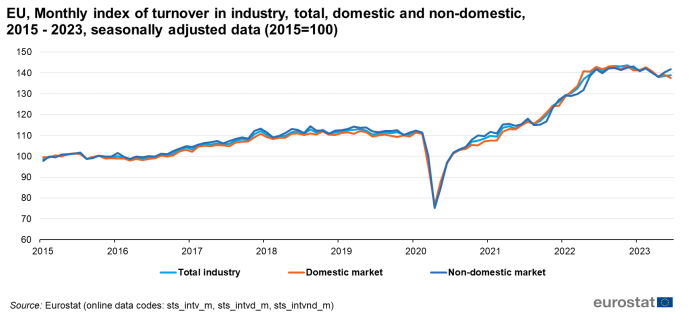Industrial turnover index overview
Data extracted in September 2023.
Planned article update: September 2024.
Highlights

Source: Eurostat (sts_intv_m), (sts_intvd_m), (sts_intvnd_m)
This article provides an overview of the development of the industrial turnover indicator in the European Union (EU), the euro area and the EU Member states over recent years, and describes how it is compiled. The index of industrial turnover is a business cycle indicator which measures the monthly development of turnover in the European industry.
The data presented in this article are taken from European short-term statistics (STS) which are collected under the European business statistics regulation. Industry turnover as presented in this article covers turnover in mining and quarrying and in manufacturing (NACE Rev. 2 sections B and C).
Full article
Overview
Industrial turnover data published by Eurostat distinguish between domestic turnover, i.e. turnover generated with sales to units in the same country and non-domestic turnover for sales from a business in one country to someone in another country (the non-domestic turnover data are further divided according to whether the buyer of the industrial goods has its seat in a euro area country or not). As Figure 1 indicates, the overall developments of domestic and non-domestic turnover data is somewhat different in level but the general patterns of domestic and non-domestic turnover are similar.

Source: Eurostat (sts_intv_m), (sts_intvd_m), (sts_intvnd_m)
Industrial turnover in the EU increased steadily but relatively slowly since 2015. In February 2020, the Covid-19 crisis set in and industrial turnover fell by more than one third in just two months. The following months from May to July saw a rapid recovery. Between July 2021 and July 2022 industrial turnover developed quite dynamically and increased by over 16%. During the following months, between July 2021 and July 2022 the dynamic even accelerated – mainly as a result of increasing prices. During this period, total industrial turnover in the EU grew by more than 20%. Since then turnover has stabilised on a rather high level.
Table 1 shows the annual rates of change of industrial turnover (mining and quarrying and manufacturing) in the European Union, the euro area, the EU Member States and some other countries for which data are available (calendar adjusted data).
The 2020 data are clearly influenced by the Covid-19 pandemic. In the EU, turnover in industry decreased by 9.8 %, in the euro area even by 10.5 %. There were, however, noticeable differences between countries. The drop in turnover was particularly strong in Luxembourg (-13.3 %), France (-12.9 %), Greece and Spain (both -12.1 %), and in Portugal (-12.0 %) while in and Latvia (2.2 %) and Ireland (1.9 %) industrial turnover increased. As a result of the recovery after the pandemic, and also as a consequence of increasing prices, industrial turnover increased quite dynamically in 2021 (EU 15.5 %, euro area 15.2 %). All countries for which data are available recorded positive rates of change, which were particularly high in Lithuania (29.3 %), Belgium (25.8 %), and Greece (25.3 %).
In 2022 industrial turnover continued its dynamic growth as a result of rapidly increasing prices levels. The EU total industrial turnover grew by 19.5%, in the euro area the rate of change was 18.8%. The highest rates of change were recorded in Bulgaria (36.1%), Greece (33.2%), and in Lithuania (30.1%).

Source: Eurostat (sts_intv_a)
Source data for tables and graphs
Data sources
The definition of turnover is rather straightforward. It comprises basically what is invoiced by the seller. Rebates and price deductions are taken into account as well as special charges that the customer might have to pay. Turnover does not include VAT or similar deductible taxes.
Information on industrial turnover is often collected by business surveys. However, quite a number of National Statistical Institutes rely on administrative sources, i.e. VAT declarations, to obtain the data.
According to the European business statistics regulation and the Implementing regulation data on service turnover have to be made available by the National Statistical Institutes on a monthly basis. European aggregates are calculated by summing up weighted national indices. The weights correspond to the share of the countries in the turnover of industrial activities in the base year.
All results for the indicator of turnover in industries are published on the Eurostat website.
Context
The turnover indicator in industry represents the development of sales in industry. It is therefore a value indicator that is influenced by two factors: changes in prices of the traded industrial goods and changes of the traded volumes of goods. Apart from the influence of price changes which constitute a differences between turnover and production volumes there are also some other methodological differences, e.g. production figures include stocked good which are not yet sold.

Source: Eurostat (sts_intv_m) and (sts_inpr_m)
In general the connection between both indicators was relatively close as is indicated by Figure 2 which represents the seasonally adjusted monthly indicator values for turnover and production in industry for the years 2005 - 2023. Figure 2 also shows that since January 2021 industrial production more or less stagnated (average monthly rate of change 0.1%) while industrial turnover grew quite dynamically (with an average monthly rate of 0.8 %). As a consequence the index of industrial turnover is now more than 30 % higher than the index for industrial production.
Direct access to
- Industry (NACE Rev.2) (t_sts_ind)
- Industry turnover index (NACE Rev.2) (t_sts_ind_tovt)
- Industry (NACE Rev. 2) (sts_ind)
- Industry Turnover Index (NACE Rev. 2) (sts_ind_tovt)
- Focus on the link between new orders, turnover and production for industrial activities - Statistics in focus 58/2007